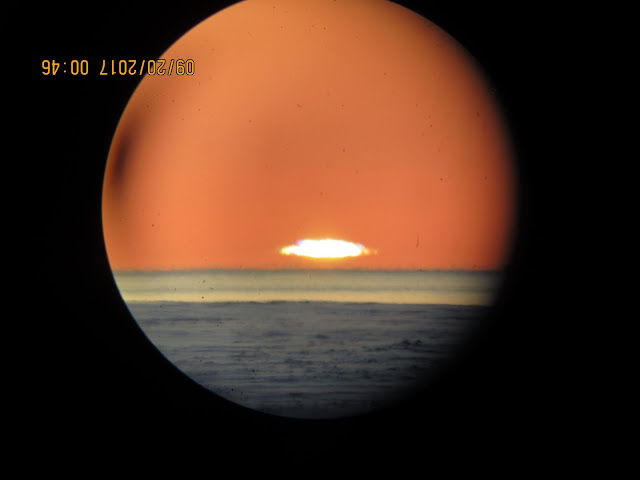~Never observed literal greening of the NW passage
~The likely cause was a much warmer top of sea opposing a quick refreeze caused by light winds...
30 Years ago Arctic top of sea refreezes, particularly here, 75 North 94.5 West, were often in early September, at the first chance of light winds, then after October was bitterly colder, fostering the onset of winter to last till June. During these older days, the boating season was about 3 to 8 weeks long, since on shore fast ice came so early and the sea ice broke up as late as August. Now this season is almost always more than 16 weeks.
Freeze-up 2017 was no different than any other except it came late, a feature of the post 1998 sea ice period. Grey ice comes almost always when there is a calming of winds during clear air events.
There is yearly one natural cloudy season for the High Arctic from Mid April to Mid September, this season has changed recently, it comes often mid April as usual, but became more intense, with heavier precipitation for months. Post 1998, this cloudy season stretched often till end of October, making freeze-up much more difficult, another component is the -11 degrees C mark, which is the most observed temperature which causes grey ice. Although sea ice freezes at -1.8 C, it takes much colder air temperatures to counter balance the net thermal top of sea state not at all at its freezing point. If there is a warming of sea water it does not mean that freeze-up will always come later, it is a matter of the right circumstances.
With right conditions: clear skies, calm seas, temperature nearing -11 C; freezing may occur. So it was September 19 2017, the winds were quite slow less than 5 knots, the sky was clear (an unusual autumnal feature), some freezing started:
Never seen before "green flash green" sea, a refraction effect not entirely understood. Definitely new, the green may be a mix between horizon sky and the natural sea water blue we usually observe at all sunsets.
Past blue seas at sunset examples abound, I picked a few:
Practically all open water sea sunsets are dark blue (grey when cloudy), even with exact 2017 conditions. The orange horizon of 2012 is identical to 2017, yet with dark blue seas.
September 19 2017 sunset occurred mid air, signifying thermal inversions, note the lack of reflection of direct sunlight over the sea, there is a band of thermal layers, called ducts, intensely stable temperature wise. This is done with clear air, light winds and in this case, the fresh formation of a very thin layer of sea ice. Right above the newly formed ice the air was automatically colder, higher up near surface air was warned by sea water before the ice showed up. Latent heat of fusion also released some heat which ascended higher by buoyancy,
But this new very thin ice did not last, temperatures warmed to the -3 to -5 C range on September 20 and 21, come the 22nd. All new sea ice was gone. Again, worth to note that sea ice may melt with surface temperatures above -11 C,

This "green flash green" ocean was a never seen before event, it showed up roughly 40 minutes after the blue ocean with the sun above the horizon at about 5 degrees C elevation (first blue sea horizon picture). With the lower sun, the orange horizon came about, implying very clean air conditions. The distant ship seen in dark shade hues was captured upright, but betrays the very complex layering just below. One of which demonstrated a Wegener blank strip, a relatively rare optical event, implying a steep thermal inversion, a blank strip is an optical construct consisting of a very long thermal duct, very distant having no light from above or under which can penetrate it, therefore the darkened layer black impression you can particularly see in the un-zoomed picture with the green sea.
Implications:
The 'never seen before' aspect of this event, is a major discovery, the reasons for the greening of the sea horizon, needs to be modeled, in other words , replicated by computer animations. Historical GRIB data should also have steep inversions above the sea surface below 46 meters ASL.
This is a splendid example of atmospheric optics readily available to verify state of the art atmospheric computer models. If the models do not have inversions below 46 ASL, they need be improved. WD October 24 2017.





















